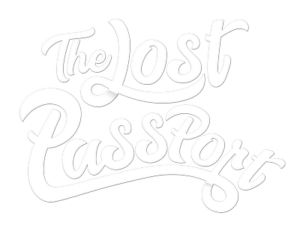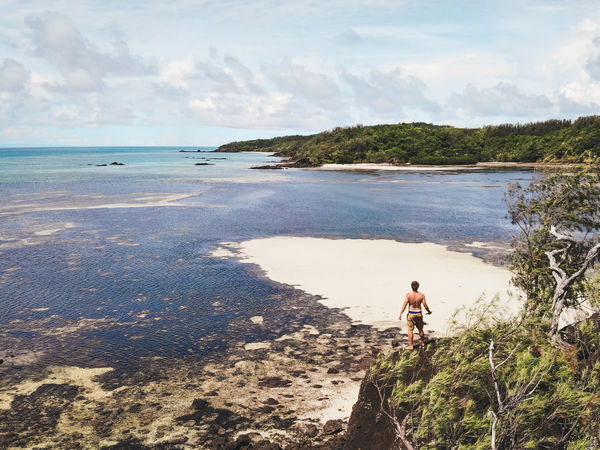1. Create Your Domain
Cheap and easy domain management: GoDaddy
Your travel blog all starts with the name. That name after the “www.” bit is your domain.
A good domain should be memorable and simple. Even better if it reflects your personality, your style of travel, or your travel niche.
In the early days this blog was called jshep-photography.com as my goal was to share my travel photography with people. The domain was super personal, but it was terrible for two reasons; it was not memorable, and it was difficult explaining the hyphen in the middle.
For a long time, I wanted to rename this blog but couldn’t think of a suitable name. One night I was packing my bag before heading to Mongolia in mid-winter. My flight was in 10 hours and I just could not find my passport anywhere – a common trait of mine.
Then the new name for this blog smacked me right in the face, so you have it – The Lost Passport.
Don’t get stuck here searching for the perfect name forever or you may never move on! You can always change your domain name down the track as I did. It actually becomes a bit easier later when you start defining your blog’s voice and niche.
It’s a bonus if the matching social media handles are available too. Again, don’t be overly concerned if they’re not as there are always workarounds. My Instagram is @thelostpasportblog while Facebook and YouTube are both TheLostPassport.
2. Choose a Host
Lightning fast hosting: Cloudways
A host has the server where all your website’s information will be stored; blog posts, photos, theme installation, comments, videos, and the list goes on…
There are thousands of hosts out there ranging from super cheap to super expensive.
At the cheap end there is shared hosting with Hostgator from just a few dollars a month. I started with them which worked for the first 6 months. Then I quickly ran into the limitations with speed, hacker vulnerability, and lack of technical support.
In Step 6 you’ll see that building an audience and a profitable blog heavily depends on website speed which is a heavy SEO requirement. Cheap hosting just won’t get you there and will ultimately restrict your income generating potential by more than good hosting costs.
In the mid-range of hosting is a Cloudways Virtual Private Server (VPS). Once I moved to their Digital Ocean 2GB plan my website became much faster. This was closely followed by a tripling in my monthly visitors after just a few weeks. The difference was that obvious.
Migrating from one host to another was quite painful, and so for all new websites I build I just go straight to Cloudways by default, no regrets.
3. Install your Theme
Super flexible theme: Elementor
You’ve got your domain name and a place to store everything. Now you can really start setting things up.
Next, you need to install WordPress, the platform that 99% of blogs run on. Here is simple guide to do that in just a couple of clicks with Cloudways.
With WordPress is installed you can customise your website. WordPress comes packaged with a very bland theme installed by default. If you’re not a web developer like 99% of travel bloggers, then a great theme to work with is Elementor. (Remember, were building a home for our travel experiences, not going to coding school, so a good theme keeps the process simple)
Elementor allows you to build fully customsed pages by dragging and dropping elements on screen. It has been a total game changer for my blog, and many others out there.
Pre-designed themes tend to lock you in to their rigid structures and come bloated with many options you don’t need. Elementor on the other hand offers you total flexibility in designing webpages. You can also switch off features you don’t need, making page load lighting fast – you’ll pick up my website speed obsession here quickly.
The free version of Elementor is great to start with. For all the useful functions you’ll want Elementor Pro. It is a powerhouse theme packed with everything you really need to set up a beautiful, easy to navigate, fast, and profitable travel blog.
4. Define Your Niche
As you can see from this guide, it’s easy to start a travel blog. It’s another thing to differentiate yourself from the thousands of other travel bloggers out there.
Travel itself isn’t really a niche, it’s an industry. By narrowing this down to your niche you can generate more focused content, consistent branding, and really start to stand out in your own smaller area.
Some ideas to consider in defining you niche are… What geographical area do you cover? What type of travel do you do? Are you focused on shorter trips, or longer trips? What’s your typical travel budget?
When this blog started it fell into the trap of trying to cover every singe country for everyone. After a couple of years this narrowed down to Southeast Asia for travellers on a 1 to 4 week trip with a flashpacker type budget.
5. Create a Logo
Thousands of designers: Fiverr
With the website essentially set up you can start to work on branding. In the early days I tried designing my own logos, and I’ll be honest, they were terrible. I’m not a designer, I’m a travel blogger and photographer.
Thankfully the internet has an abundance of freelancers through platforms such as Fiverr. You can have a logo designed for as little as jut $5 and it can be turned around in under one day. The logo for my website cost about $40 as I decided to use a more premium artist that provides my with not only JPEGs but also the Abode Illustrator files for future modification.
6. Start Writing Content
Unleash your travel experiences onto your new travel blog in a place where thousands, perhaps millions, of other people will come to discover them.
A common misconception is that trave bloggers are always on the road writing about their current travels. This may be true for some, but not the majority. You can easily write hundreds of articles based on your past travel experiences and photos taken.
By the time this travel blog launched I was able to produce over 100 articles without needing to hit the road again (of course I was back out there exploring though).
Create useful content that will get shared. Blend your personal travel experiences and writing voice with information that answers the questions of your readers. “How do I get to XYZ island” or “what are the best restaurants in XYZ city” are examples of common questions you can answer.
7. Build your audience (learn about SEO)
Understand your reader’s needs: UberSuggest
How do you actually get people to your blog without spamming family and close friends with your anecdotal travel stories? Also, no paying for your audience!
To date I’ve had millions of travellers visit this blog searching for insightful travel tips. The key to this is Search Engine Optimisation – abbreviated SEO. With useful tools you can understand what words people are using when searching on Google, Bing, or other search engines while planning their trip.
It is possible to get a high level understanding of search words using Google Adwords Keyword Planner. However, to create effective content that appears in the top Google search results you’ll want to use a paid keyword research tool like Ubersuggest or Keysearch. I’ve used both over the years but find Ubersuggest to provide more accurate and informative insights.
There are other ways to build your audience using platforms like Pinterest, Instagram, and Facebook. Remember though, that the audience you have on those platforms remains on those platforms. The audience you have on your blog is entirely yours and algorithms can’t change that!
Now the money making bit, here’s what you want to know to have your adventures funded by your travel blog!
8. Set up Google Ads
The simplest way to make money with your travel blog right out of the box is with display advertising. Google Ads allows you to place ads on your website, and pays you in return for visitor views and clicks.
Income varies quite significantly based on what content you create and where your audience comes from. Visitors from Europe and he USA typically pay better than users from Asia.
As your travel blog continues to grow to 100,000 readers per month or more you can switch to more lucrative display advertising partners like Mediavine. Many big travel bloggers totally plaster their articles with disruptive ads to squeeze a few extra pennies. You’ll notice this blog does not do that and I put reader experience first.
Display advertising is a good way to start making some money, but it probably won’t ever completely fund your travels around the world.
9. Sign up for Affiliate Programs
Affiliate what? Affiliate programs allow you to sell other companies services or products in return for a commission. Some of these commissions can be quite lucrative and easily outweigh the earnings you make from display advertising.
Common affiliate programs for travel bloggers are:
- Agoda: used for hotel bookings. Affiliate commissions start from 4% and increase up to 7% based on the total number of bookings made within the month.
- 12Go: used for transport bookings including bus, train, ferry, speedboat, private transfer and so much more. Affiliate commissions are up to 50% of the agent’s fee. It’s a bit unclear compared to Agoda’s policy, but still a great program to make decent earnings.
- Viator, Klook, Get Your Guide, TakeMeTour: these are tour aggregators offering varying commissions for successful bookings. Different programs are more or less effective in different areas of the world. This blog primarily works with TakeMeTour which is Asia-centric and offers flexible private day trips as opposed to cookie-cutter group tours.
- Amazon: not actually travel but the world’s largest online marketplace where you can make commissions by recommending the travel gear that you use. Pro tip: if a reader clicks your link recommending your hiking shoes, but ends up purchasing a TV, you still make the commission!
A little disclaimer: the recommendations I have made in this guide to services that I personally use such as GoDaddy, Cloudways, and Elementor also reward me with affiliate commissions. This comes at no extra cost to you and is seen as a marketing expense by those service providers. If you’re intent of setting up your blog, I really appreciate your support by purchasing up via my links!
10. Continue to Optimize
What you’ve learned so far is merely how to start your travel blog and set it up in a way that makes you some money. If you want your travel blog to pay for your world travels (as this blog does for me) you need to continue learning, improving and optimising.
One of my favourite (and often underrated) optimisation tools is Google Search Console. This allows you to see what search terms you content has appeared in Google for over time. Use these as a guide for how to expand upon and reshape you existing or new content.
Be patient, create good content, and optimise often. Over time your audience will grow from tens to tends of thousands of visitors per day. When this does, the money for your travels will also flow.
Bonus: How Much Can You Make Travel Blogging?
Some travel bloggers make well over $100,000 per year. This travel blog currently earns me just over $25,000 per year which pays for all of my international travel and photography equipment.
How much you make depends on how much you learn and continue to grow. You don’t have to limit your revenue streams to just affiliate marketing and display ads, it is possible to expand by creating your own products such as ebooks and maps, running your own tours, offering premium travel planning services, and so much more. Get creative!
Got any questions? Ask below or drop me a direct message on Instagram. I’ll aim to get back to you within a coupe of days, unless I’m out on the road somewhere remote.




